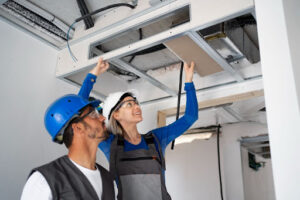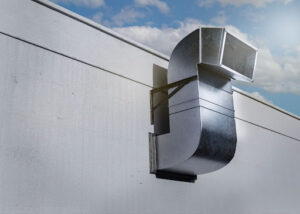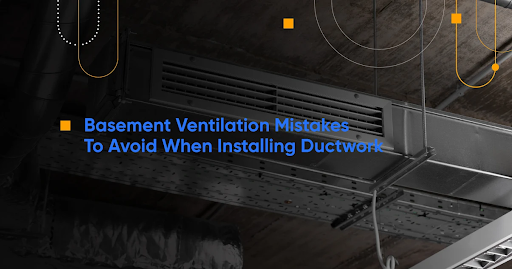The basement ventilation system is designed to improve airflow and maintain healthy air quality in below-ground spaces. It helps prevent problems like dampness, mold growth, and musty odours caused by the circulation. By removing stale, humid air and bringing in fresh air, these systems protect both the structure of the home and the health of its occupants. But, many-a-times, proper basement ventilation is often overlooked, knowing that it plays a vital role in maintaining a healthy and comfortable home. This blog will highlight the key basement ventilation mistakes to watch out for, helping you create a healthier, safer, and more efficient space.
8 Common Ductwork Mistakes in Basement Ventilation System!
Poorly designed or improperly placed ducts can lead to issues like uneven temperatures, mold growth, and higher utility bills. By understanding the 8 most common mistakes homeowners make during installation, you can avoid costly errors and ensure your system performs optimally
1. Ignoring Moisture in Your Basement Ventilation System
Underground spaces are naturally damp, making them vulnerable to excess humidity and poor airflow. Installing ductwork without addressing moisture can lead to mold, mildew, and even structural damage. Damp conditions allow allergens and bacteria to thrive, reducing the effectiveness of your basement ventilation system.
Preventive Measures – Seal cracks or leaks in walls and floors, install vapor barriers, and use dehumidifiers to keep humidity under control.
Long-Term Benefits – Managing moisture ensures healthier indoor air, protects ductwork efficiency, and prevents costly repairs.
2: Poor Ductwork Placement in a Basement Ventilation Design

Placing ducts too close to walls, ceilings, or obstacles limits circulation and reduces system performance. Such poor placement can cause hot and cold spots, making your basement uncomfortable year-round. Also, when ducts are blocked or misaligned, your basement ventilation system must work harder thereby, increasing energy costs.
Professional Planning Matters – Strategic duct placement ensures balanced airflow throughout the space.
Better Comfort & Savings – Correct positioning improves air circulation, lowers energy bills, and extends the life of your system.
3: Wrong Duct Size in Basement Ventilation Requirments
Undersized ducts restrict airflow, while oversized ducts waste energy and reduce system efficiency. Often, incorrect sizing leads to uneven heating or cooling, leaving parts of the basement uncomfortable. Also, poorly sized ducts force your HVAC to work harder, shortening its lifespan and raising utility costs.
Role of Professional Design – Accurate load calculations and expert planning are key basement ventilation requirments.
Optimized Performance – Properly sized ducts ensure balanced airflow, better energy efficiency, and consistent comfort throughout the space.
4: Failing to Insulate Ducts in Basement Ventilation Design
Uninsulated ducts allow heated or cooled air to escape, reducing the efficiency of your system.
The temperature differences in basements often cause condensation on ducts, leading to mold or rust. Plus, the moisture buildup can spread allergens and compromise indoor air quality.
Importance of Insulation – Adding insulation is a critical step in effective basement ventilation design, ensuring energy is not wasted.
Long-Term Advantages – Properly insulated ducts improve comfort, reduce energy bills, and extend system durability.
5. Overlooking Return Air Vents in a Basement Ventilation System

Many homeowners install supply vents but forget return vents, disrupting airflow balance. Without returns, stale air lingers, and your basement ventilation system cannot function effectively. Lack of return air vents allows damp air to remain trapped, encouraging mold growth. Imbalanced airflow forces your HVAC to work harder, raising energy use and reducing lifespan.
Balanced Performance – Properly placed return vents create even air circulation, stabilize humidity, and improve overall basement comfort.
Benefits: Efficient air circulation, HVAC system optimized, reduced electricity bills and healthy indoor air quality.
6: Not Sealing Duct Joints Properly in Basement Ventilation Design
Poorly sealed duct joints allow conditioned air to escape, reducing efficiency and increasing energy bills. Improperly sealed ducts disrupt airflow, leaving some areas of the basement stuffy while others stay too cold or warm. Gaps in duct joints can draw in damp basement air, which undermines effective basement ventilation design.
Go for long-term fixes – Standard duct tape wears out quickly; only mastic sealant or UL-approved tape ensures long-lasting seals.
Efficiency Gains – Properly sealed ducts improve energy efficiency, extend HVAC lifespan, and create a more consistent indoor climate
7: DIY Installation Without Professional Guidance in Your Basement Ventilation System
Going for DIY installation to cut save ductwork installation cost, without proper technical skills and knowledge lead to poor airflow, leaks, and uneven temperature distribution. Also incorrectly installed ducts may create fire hazards or compromise indoor air quality. There is a high probability of local code violations as DIY work might not meet local building or HVAC codes, causing future compliance issues.
Long-Term Costs – DIY installations lead to mistakes that often result in costly repairs or replacements down the line.
Professional Advantage – Hiring experienced technicians ensures your basement ventilation system is properly designed, installed, and optimized for comfort, efficiency, and safety.
8: Ignoring Overall Basement Ventilation Requirments
Common flaws in implementing overall basement ventilation design like Installing ducts without considering the complete system limits airflow efficiency. The basement should work in harmony with your main heating and cooling system for consistent temperatures. Overlooking proper ventilation leads to moisture entrapment, mold growth and reduced air quality. Therefore, neglecting a holistic approach leads to uneven heating/cooling and a less comfortable basement.
Energy Efficiency – A well-integrated basement ventilation design reduces energy costs by ensuring all components work efficiently.
Long-Term Health Benefits – Complete system integration prevents mold, allergens, and moisture-related issues.
So Ready to Optimize Your Basement Ventilation Design?
Ensuring a proper basement ventilation system goes far beyond simply installing ducts. Each aspect ranging from moisture control and duct placement to insulation, return vents, and overall system integration, plays a critical role in maintaining a comfortable, healthy, and energy-efficient basement. By addressing these common mistakes, you can prevent mold growth, uneven temperatures, and unnecessary energy costs. A well-planned basement ventilation design not only improves air quality but also extends the life of your HVAC system and enhances the overall comfort of your home.
Trust the experts at Basement Finishing to evaluate, design, and install a complete ventilation solution tailored to your space with affordable ductwork installation cost.
Contact us today to schedule a consultation and optimize your basement for safety, comfort, and efficiency.
Frequently Asked Questions
1. What is a basement ventilation system, and why is it important?
A basement ventilation system helps circulate air, control humidity, and prevent mold growth. Proper ventilation ensures healthier indoor air quality and energy efficiency.
2. How can I maintain my basement ventilation system for long-term performance?
Regular inspection, cleaning ducts, sealing leaks, and monitoring humidity levels are key to keeping your basement ventilation system efficient and preventing costly issues.
3. What are the essential components of an effective basement ventilation design?
A proper basement ventilation design integrates supply and return ducts, HVAC systems, dehumidifiers, and air purifiers to maintain consistent airflow and comfort.
4. How does basement ventilation design affect energy efficiency and comfort?
A well-planned basement ventilation design ensures balanced airflow, reduces energy costs, and keeps the basement temperature comfortable year-round.
5. Can I upgrade my existing basement ventilation design without major renovations?
Yes. Upgrades like adding insulation, optimizing duct placement, or integrating dehumidifiers can enhance your current basement ventilation design without large-scale remodeling.
6. What common mistakes should I avoid in basement ventilation design?
Ignoring moisture, poor duct placement, undersized ducts, and a lack of system integration are key mistakes. Proper planning of your basement ventilation design prevents mold, uneven airflow, and energy loss.

